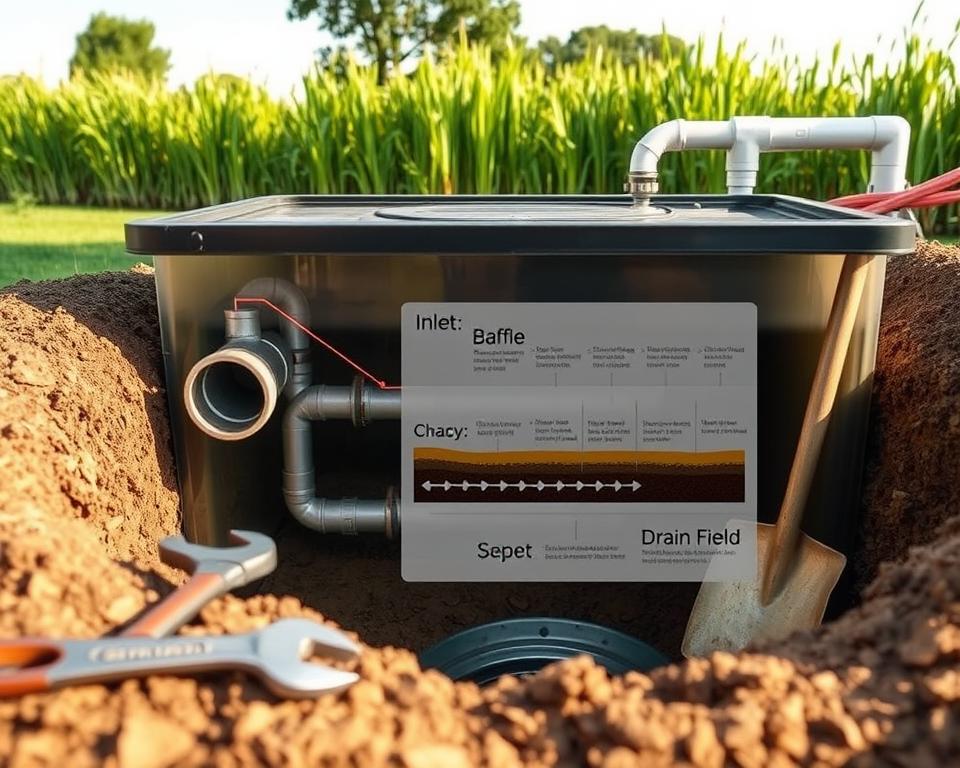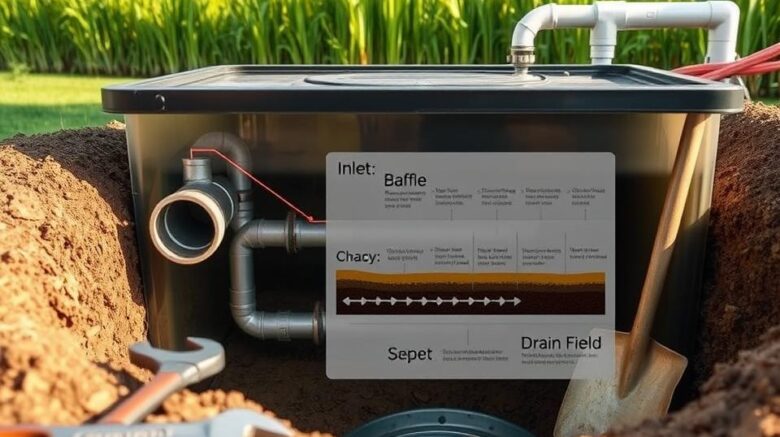Aerobic Tank Air Pump: Comprehensive Guide for Residential Users
Do you sometimes think about what boosts your aerobic septic system’s effectiveness? The Septic air pump is the unrecognized hero indispensable for your system. In this article, property owners will get essential knowledge on the Septic air pump’s importance. It’s critical for a sound, optimized Septic system.
Appreciating the value of a Septic tank air Pump can enhance your Septic system’s capabilities using septic service near me. It also safeguards your home equity and surrounding ecosystem. Our handbook will feature All in Sanitation, a reputable Septic industry leader. They’re equipped to meet your Septic aerator Pump requirements.
Central Ideas
- The Septic air Pump is paramount for air-driven Septic tanks.
- Servicing your Septic system air Pump can improve overall system operation.
- Routine inspections extend the longevity of your Septic tank air Pump.
- Choosing the correct Septic aerator Pump is essential for optimal operation.
- All in Sanitation provides specialized services for Septic air Pump solutions.
Breaking Down Aerobic Septic Units
Aerobic Septic systems deliver a more effective waste treatment approach by using oxygen. This method employs aerobic bacteria thriving in well-oxygenated environments. These bacteria are faster in digesting organic matter. With the help of Septic aerator Pumps, these systems provide a continuous oxygen supply, enhancing the waste decomposition process.
These systems perform well in lowering sludge buildup, owing to the hard work of aerobic bacteria. This reduction in solid waste means less maintenance and tank emptying is required less often. Additionally, they successfully handle wastewater, producing minimal smells. This yields a improved environment for homeowners and the community overall.
To confirm these systems operate properly, it’s important to recognize the key Septic system components. These include the Septic tank, treatment chamber, and effluent Pump. Each component serves a key function, especially the air Pump. It forces oxygen into the tank, crucial for the aerobic bacteria’s performance.
Significance of the Septic Air Pump
The Septic air Pump is key in the performance of aerobic Septic systems. It functions like the system’s “oxygen source,” providing the needed oxygen mandatory. This oxygen allows aerobic bacteria to operate efficiently and digest waste efficiently. If the Pump fails, the system’s efficiency decreases, causing sludge collection and possible odors.
Such issues can undermine Septic system operations and create environmental hazards. By realizing how critical the Septic air Pump is, homeowners can act preemptively. They can maintain its peak function through scheduled service. This stops failures, sidesteps costly repairs, and keeps the aerobic system’s integrity.
Top Advantages of Using a Septic Air Pump
Running a Septic air Pump significantly boosts the effectiveness of Septic systems. Septic air Pumps are vital as they quicken the decomposition of waste. This is accomplished by oxygenating the treatment process, stimulating aerobic bacteria growth. These bacteria are vital for efficient waste treatment.
They’re also important in minimizing foul smells. Thanks to more active aerobic processes, waste breaks down faster, thus cutting down odors. This creates a nicer atmosphere for homeowners.
Another important benefit is the cut in sludge collection. Consequently, tanks demand less frequent Pumping, conserving both money and time. Enhanced processing not only reduces spending but also prolongs the lifespan of the drain field.
Looking after these Pumps diligently means reduced repair costs and complying with regulatory standards. Thus, the upsides of Septic air Pumps go beyond being for homeowners. They also support environmental health by advancing waste management practices.
| Benefit | Description |
|---|---|
| Fast Waste Breakdown | Enhanced aerobic activity speeds the decomposition process. |
| Minimized Odor Emissions | Superior treatment efficacy creates fewer odors. |
| Reduced Sludge Buildup | Reduced Pumping and maintenance are called for. |
| Extended Drain Field Life | Better treatment means a healthier drain field. |
| Cost Savings | Lower likelihood of repairs and regulatory compliance cost. |

Picking an Ideal Septic Air Pump
Choosing the right Septic air Pump is essential for an effective aerobic system. Homeowners ought to review various factors for the best fit. The size of the tank and the airflow specifications matter greatly the Pump’s efficiency.
To select well, it’s useful to understand the air Pumps available. There are mainly two types: diaphragm Pumps and rotary vane Pumps. Each offers particular pluses, which should be matched with your home’s specific needs and how it operates.
Power consumption also matters. Opting for a Pump that minimizes energy use while delivering the needed airflow can yield lower utility bills. Assistance from All in Sanitation experts can be invaluable. They verify the Pump you choose matches your system’s requirements perfectly.
Popular Categories of Septic Air Pumps
Homeowners can decide more effectively by knowing the various Septic air Pumps available. There are mainly two types: diaphragm Pumps and rotary vane Pumps. Each has its particular functions and benefits.
Diaphragm Pumps, valued for their quiet operation, are popular for residential Septic systems. They provide energy efficiency while ensuring stable air output. Their dependable performance fits smaller systems, meeting the needs of many homeowners.
Rotary vane Pumps, however, are ideal for larger or commercial systems. These Pumps provide more power, necessary for handling bigger loads. Their durable build delivers efficient operation in heavy-duty Septic systems.
| Type of Pump | Best Use | Advantages |
|---|---|---|
| Diaphragm Pumps | Residential Systems | Quiet operation, energy-efficient, reliable air flow |
| Rotary Vane Pumps | Larger or Commercial Systems | Powerful performance, high capacity, durable construction |
Understanding the contrasts in Septic air Pumps is vital for upgrades or replacements. Each Pump type offers specific features to address various needs. This provides best performance for any system.
How to Tell You Need a Septic Air Pump Replacement
Homeowners must be alert to Pump failure signs in their Septic systems. Some clues indicate the need for a Septic air Pump replacement. These support reliable function. Identifying these quickly prevents larger issues.
Signs of potential problems include:
- Unusual noises from the Pump, like grinding or vibrating, might suggest internal damage.
- A clear lack of air output indicates the Pump isn’t performing as intended, affecting efficiency.
- Ongoing electrical problems, such as circuit trips or flickering lights, could indicate overloading.
- Visible damage on the Pump unit, with fractures or leaks, demands quick action.
- Foul odors in the yard often reveal a compromised Pump, showing ineffective effluent aeration.
Recognizing these signs early avoids high repair bills or total system failure. Performing routine inspections helps identify these issues. It also shows if you require a new Septic air Pump.
Care Guidelines for Your Septic Air Pump
For an effective Septic air Pump, periodic care is necessary. This makes sure that your system functions properly. Homeowners can follow several practical care strategies for best results.
Half-yearly, perform a comprehensive inspection for wear or damage. It is also essential to replace the filters as suggested. This stops clogs that could reduce efficiency.
The Pump should stand on a stable base to cut vibrations, which could damage it over time. A protective cover is vital too. It guards against debris and water, keeping the Pump’s functionality.
Proper maintenance can significantly increase the life of your Pump. In turn, this enhances the Septic system’s performance in general.
| Maintenance Task | Frequency | Benefits |
|---|---|---|
| Inspect Pump for damage | Every 6 months | Finds faults promptly |
| Replace filters | As needed | Keeps performance up |
| Check surface stability | Annually | Minimizes shake |
| Clear debris around Pump | Monthly | Avoids obstruction |
Fitting Your Septic Air Pump
Correct installation of your Septic air Pump is key for its reliable operation. At the outset, pick a safe, moisture-free area for placement. The chosen spot should securely support the Pump’s weight easily.
To successfully set up your Pump on your own, use the following guidelines:
- Prepare all necessary items, including the Pump, a power source, and hose fittings.
- Thoroughly review the manufacturer’s guidelines before beginning your installation.
- Verify every connection is proper to eliminate air leaks that hurt performance.
- After assembly, conduct a test to ensure the system works as intended.
If the installation process appears difficult, contact All in Sanitation. Their professionals can circumvent common errors, making sure your setup follows relevant safety requirements.
Advantages of Using All in Sanitation for Your Septic Air Pump Solutions
When picking a Septic service provider, the choice is important. All in Sanitation distinguishes itself by providing dependable Septic air Pumps. They cater to varied homeowner requirements with a broad selection of premium products. This guarantees customers find an perfect match for their Septic systems.
What clearly distinguishes All in Sanitation is beyond their extensive product lineup. Their commitment to excellent customer service is also critical. Homeowners get knowledgeable support, steering them toward trusted Septic solutions. This collaboration is important to adapt each solution to fulfil specific needs.
All in Sanitation also puts first aftercare to ensure lasting satisfaction. Their commitment goes beyond the initial sale. They deliver ongoing support to preserve Septic systems functioning optimally for the long haul.
Expense Overview for Septic Air Pumps
Knowing the costs tied to Septic air Pumps is important for homeowners using aerobic Septic systems. To start, one faces the price tag, which includes the Pump and associated accessories. Installation expenses change, based on the system’s complexity and any changes required.
Ongoing upkeep forms an additional cost layer. Routine checks can head off bigger issues, eventually resulting in savings. Homeowners should plan for Septic maintenance to keep the Pump’s effectiveness and durability. Such planning helps dodge expensive repairs later on, highlighting the benefit of proactive maintenance.
| Cost Component | Average Cost Range |
|---|---|
| Septic Air Pump | $500 – $1,200 |
| Installation | $300 – $800 |
| Annual Maintenance | $150 – $400 |
| Potential Repair Costs | $1,000 – $5,000 |
Itemizing Septic air Pump expenses into separate parts aids homeowners in cost forecasting. This comprehensive approach provides the system’s consistent operation and their comfort.
Conclusion
For homeowners with aerobic Septic systems, looking after Septic tanks is crucial. The suitable Septic air Pump boosts waste processing and increases your system’s life. Scheduling consistent service and promptly addressing issues prevents expensive repairs and disruptions.
Choosing a Septic air Pump warrants attention. This guide highlighted how to choose wisely about installation and replacement. With All in Sanitation’s expertise, you can manage your Septic systems’ complexities securely.
Attending to your Septic air Pump improves your system’s functionality and durability. It guarantees a trouble-free and effective operation over time. Keep in mind, your home’s wastewater management is greatly improved by proper care.
